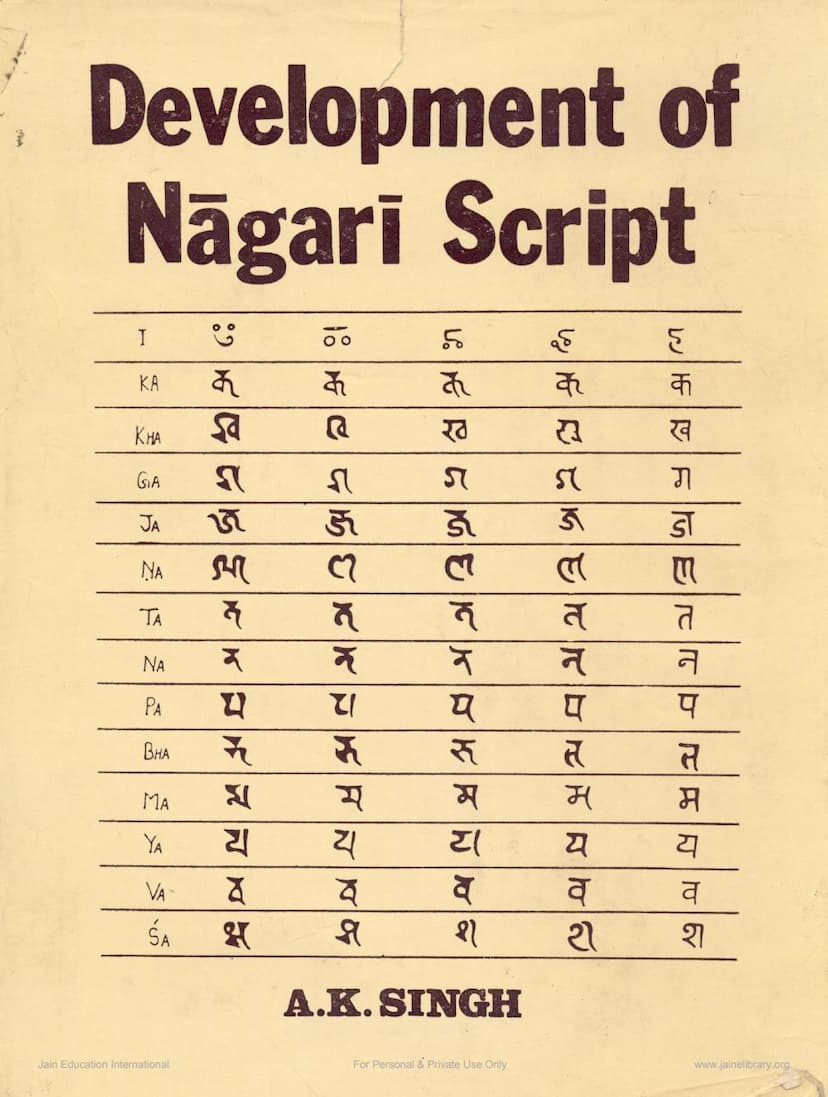Development Of Nagari Script
Added to library: September 1, 2025

Summary
This book, "Development of Nāgarī Script" by A. K. Singh, published by Parimal Publications in 1991, is a comprehensive academic study tracing the evolution of the Nāgarī script.
The central thesis of the book is that the Nāgarī script is not an independent creation but rather an evolutionary outcome of the Mauryan Brāhmī script. The author argues that any theory of independent origin for Nāgarī is superfluous.
Here's a breakdown of the key points and stages discussed in the book:
-
Origin from Brāhmī: The book establishes that Nāgarī's roots lie firmly in the ancient Brāhmī script. While early stages of Brāhmī development (from Mauryan to the mid-6th century AD) show only a few similarities to Nāgarī, the emergence of the Kuṭila alphabet towards the end of the 6th century AD marks a significant acceleration in the evolutionary process towards Nāgarī.
-
Key Evolutionary Stages:
- Mauryan Brāhmī: Characterized by simple geometric forms.
- Pre-Kshatrapa and Kshatrapa Periods: Show some development, with tapering vertical strokes.
- Kushāna Period: Exhibits increasing cursiveness, with distinct eastern and western forms.
- Gupta Period: Further development and progression in letterforms.
- Aulikara and Maukhari Periods: Western Indian styles become more distinct, and Brāhmī transforms into the Kuṭila script.
- Kuṭila Alphabet (6th-8th Century AD): This stage is identified as a crucial link between Brāhmī and Nāgarī. Key features include inward bending of right vertical limbs, acute angles with the base line, triangular top heads, and ornamented medial signs, often influenced by pen techniques. The Kuṭila script spread geographically across North India and influenced scripts in various regions.
- Period of Transition (9th-10th Century AD): During this period, the Kuṭila script rapidly evolves, completing its transition into Nāgarī. The dominance of empires like the Palas, Pratīhāras, and Rāshtrakūtas influenced regional variations, leading to eastern, northern, and western styles.
- Age of Maturity (11th-13th Century AD): Nāgarī, characterized by fully developed top-strokes (head-lines), straight vertical lines, standardized medial signs, and simplified ligatures, reaches maturity. This mature form is seen across various regions, although minor variations persist due to local influences, writing materials, and individual scribal styles. The book details the development of Nāgarī in Eastern India (Bihar-Bengal, Assam, Orissa), Northern India (Middle Ganga Valley, Central India, Rajasthan), and Western India & Deccan (Gujarat, Maharashtra, Karnataka).
- Manuscript Nāgarī: The book also dedicates a section to the evolution of Nāgarī in manuscripts, highlighting the materials used (palm-leaf, birch-bark) and the variations observed in Buddhist and Jaina traditions. It notes that manuscript writing often shows earlier or more fluid forms compared to epigraphic evidence.
-
Characteristics of Mature Nāgarī: The book identifies several defining features of the developed Nāgarī script:
- Full Breadth Head-line: A consistent top-stroke covering the entire width of the letter.
- Straight Vertical Lines: Replacing the crooked shapes of earlier stages.
- Simplification: Favoring simpler forms over elaborately twisted shapes.
- Uniformity in Medial Signs: Using a single sign for each medial vowel, unlike earlier practices.
- Compendious Consonants in Ligatures: Where the first consonant is often mutilated and placed beside the second, unlike the earlier practice of stacking full forms.
-
Factors Influencing Development: Singh discusses various factors that contributed to the script's evolution:
- Economy of Effort: Simplification and conciseness in letterforms.
- Desire for Ornamentation: Leading to decorative flourishes and embellishments.
- Political Changes: The rise and fall of empires and the resulting spread and standardization of scripts.
- Regional and Inter-regional Influences: Interactions between different geographical areas.
- Writing Materials: The impact of palm-leaf, birch-bark, and paper on script formation.
- Writing Techniques and Tools: The use of pens versus styluses, and the effect of broader or finer nibs.
- Individual Mannerisms of Scribes: Personal styles influencing letter formation.
- Migration of Learned Persons: The spread of writing styles through scholars and poets traveling across regions.
-
The Appellation "Nāgarī": A significant portion of the introductory chapters is dedicated to exploring the etymology and historical usage of the term "Nāgarī" and "Devanāgarī," examining various theories from scholars like A.C. Burnell, A.H. Dani, N.N. Vasu, Hiranand Sastri, V.S. Agrawala, and others. The book suggests that the term likely had a geographical connotation related to "Nagara" or a specific region.
-
Stagnation and Standardization: The author notes that after reaching maturity by the 13th century AD, the Nāgarī script became relatively stagnant in its evolution. The advent of printing technology further standardized the script into its modern form, largely blocking further natural evolution.
In essence, "Development of Nāgarī Script" is a meticulous and detailed account of the script's transformation from its ancient Brāhmī origins through various intermediate stages, culminating in its mature form by the 13th century AD, with a keen eye on regional variations and influencing factors.